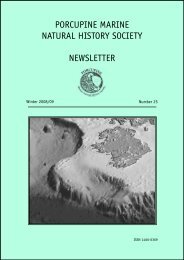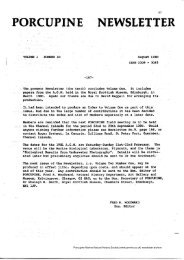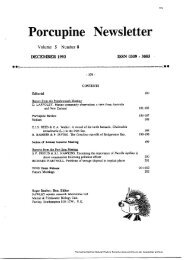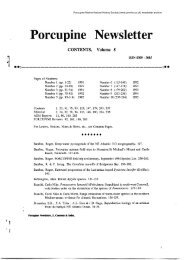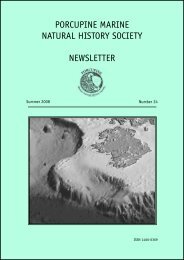Porcupine Newsletter - Porcupine Marine Natural History Society
Porcupine Newsletter - Porcupine Marine Natural History Society
Porcupine Newsletter - Porcupine Marine Natural History Society
Create successful ePaper yourself
Turn your PDF publications into a flip-book with our unique Google optimized e-Paper software.
Fig.4 Rhizostoma octopus photographed in<br />
Worbarrow Bay, Dorset Photo: P.Tinsley<br />
Barrel or Root Mouth jellyfish Rhizostoma<br />
octopus, Linnaeus, 1788.<br />
This species can be identified from the<br />
white umbrella trimmed with a dark rim.<br />
There are no peripheral tentacles, only eight<br />
central arms fused together for most of their<br />
length. Instead of having one mouth opening<br />
R. octopus has hundreds of tiny openings. It<br />
has a large bell up to 900mm in diameter.<br />
The stinging cells are deadly to its prey but<br />
harmless to humans. More commonly found in<br />
the warmer waters off the British south and<br />
west coasts, a southern boreal distribution<br />
(Russell, 1970), during late summer and<br />
autumn.<br />
Records and jellyfish survey<br />
There is remarkably little known about the<br />
distribution of jellyfish in British continental<br />
waters as very few organisations keep records.<br />
They are also quite difficult to preserve in good<br />
condition, consequently specimens in museum<br />
collections are inadequate to reliably interpret<br />
information about distribution.<br />
The <strong>Marine</strong> Life Information Network for<br />
Britain & Ireland (MARLIN) and The <strong>Marine</strong><br />
Biological Association of the UK (MBA) provide<br />
useful information on jellyfish ecology and<br />
identification.<br />
A current programme organised by<br />
the <strong>Marine</strong> Conservation <strong>Society</strong> called the<br />
“Jellyfish Survey”, aims to collate quantitative<br />
data from coastal sightings around Great<br />
Britain then publish their results in 2-3 years<br />
time. Information about the survey can be<br />
found on their website (www.mcsuk.org) and<br />
identification sheets can be down loaded.<br />
If you wish to find out more contact Peter<br />
Richardson, Species Policy Officer on 01989<br />
566017, email peter@mcsuk.org<br />
If you have specimens of Scyphozoa from<br />
around the British coasts and you would like<br />
their identification confirmed send them to<br />
s.chambers@nms.ac.uk<br />
References<br />
Erwin, D. and Picton, B. 1995. Guide<br />
to Inshore <strong>Marine</strong> Life. <strong>Marine</strong> Conservation<br />
<strong>Society</strong>. Immel Publishing.<br />
Gibson, R., Hextall. B. Rogers, A. 2001.<br />
Photographic Guide to the Sea and Shore<br />
Life of Britain and Northwest Europe. Oxford<br />
University Press.<br />
Naylor, P. 2000. <strong>Marine</strong> Animals of the<br />
South West. Sound Diving Publications. 38-39<br />
pp<br />
Russell, S. F. 1970. The Medusae of the British<br />
Isles, Pelagic Scyphozoa with a supplement to<br />
the First Volume on Hydromedusae. Cambridge<br />
University Press.<br />
PMNHS <strong>Newsletter</strong> No.19 Feb 2006 11<br />
<strong>Porcupine</strong> <strong>Marine</strong> <strong>Natural</strong> <strong>History</strong> <strong>Society</strong> (www.pmnhs.co.uk) newsletter archive<br />
11



